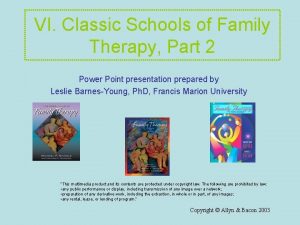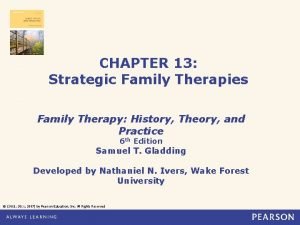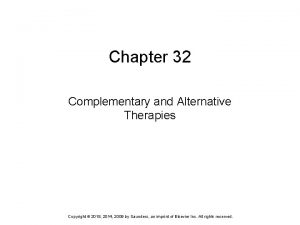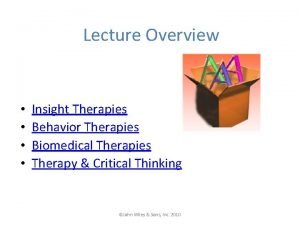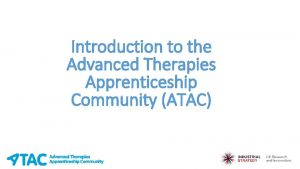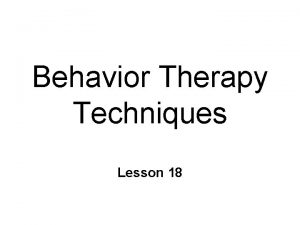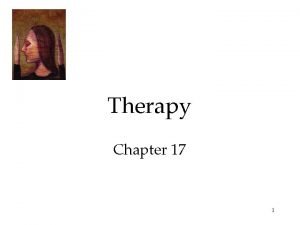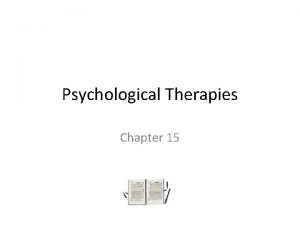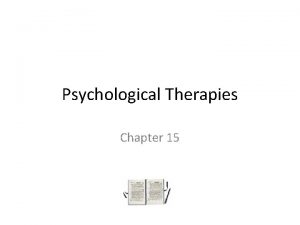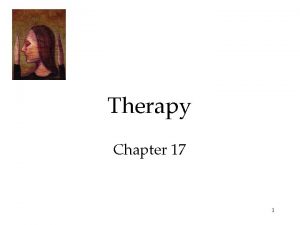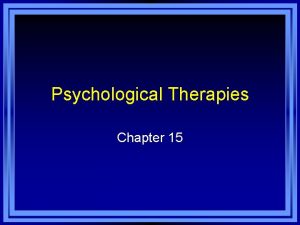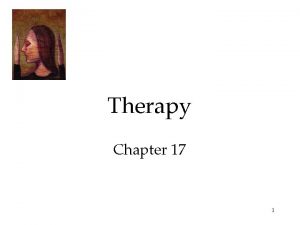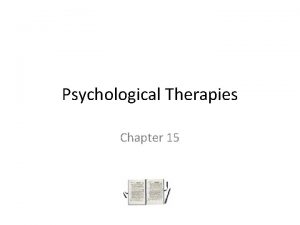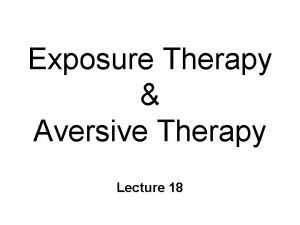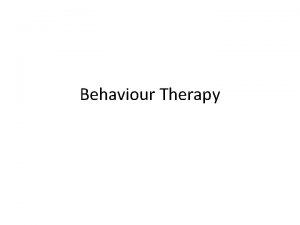CHAPTER 13 Strategic Family Therapies Family Therapy History















- Slides: 15

CHAPTER 13: Strategic Family Therapies Family Therapy: History, Theory, and Practice 6 th Edition Samuel T. Gladding Developed by Nathaniel N. Ivers, Wake Forest University © (2015, 2011, 2007) by Pearson Education, Inc. All Rights Reserved

Overview • Overview of Strategic Family Therapy • Influence of Milton Erickson • Major theorists • Premises of theory • Techniques • Roles of therapist • Processes and Outcomes • Uniqueness of the Therapy Gladding, Family Therapy: History, Theory, and Practice, 6 th Ed. © (2015, 2011, 2007) by Pearson Education, Inc. All Rights Reserved 13 -2

Strategic Family Therapies • Strategic Family Therapies are method oriented and brief in duration. • Influenced by the work of Milton Erickson • Three distinct branches of strategic family therapy • The strategic family therapists of the mental research institute • The strategic family therapists of the Family Therapy Institute (Jay Haley) • The strategic family therapists of the Milan Institute Gladding, Family Therapy: History, Theory, and Practice, 6 th Ed. © (2015, 2011, 2007) by Pearson Education, Inc. All Rights Reserved 13 -3

Strategic Family Therapy: Influence of Milton Erickson • The term, strategic therapy, was coined by Jay Haley to describe the work of Milton Erickson • Milton Erickson • Especially attuned to the power of the unconscious mind as a creative, often positive, solution-generating entity • Paid particular attention to details of the symptoms his clients presented Gladding, Family Therapy: History, Theory, and Practice, 6 th Ed. © (2015, 2011, 2007) by Pearson Education, Inc. All Rights Reserved 13 -4

Milton Erickson Continued Achieved his objected in therapy through the following procedures: • • Accepting and emphasizing the positive • Using indirect and ambiguously worded directives • Encouraging or directing routine behaviors so that resistance is shown through change and not through normal and continuous actions Gladding, Family Therapy: History, Theory, and Practice, 6 th Ed. © (2015, 2011, 2007) by Pearson Education, Inc. All Rights Reserved 13 -5

Major Strategic Theorists • Paul Watzlawick • John Weakland • Jay Haley • Cloé Madanes Gladding, Family Therapy: History, Theory, and Practice, 6 th Ed. © (2015, 2011, 2007) by Pearson Education, Inc. All Rights Reserved 13 -6

Jay Haley • Learned hypnosis from Erickson in 1953 • Incorporated much of Erickson’s ideas into his own concepts about how to do therapy • First editor of the initial journal in the field of family therapy, Family Process. • Helped to organize the Institute for Family Counseling Gladding, Family Therapy: History, Theory, and Practice, 6 th Ed. © (2015, 2011, 2007) by Pearson Education, Inc. All Rights Reserved 13 -7

Cloé Madanes • Born and raised in Argentina • Gentler in her approach to strategic family therapy than Haley • Developed the pretend technique • One of her lasting contributions was in the areas of sex and violence Gladding, Family Therapy: History, Theory, and Practice, 6 th Ed. © (2015, 2011, 2007) by Pearson Education, Inc. All Rights Reserved 13 -8

Premises of the Theory • Follows many of Milton Erickson’s principles • Emphasize short-term treatment of about 10 sessions • “No one evaluates which solutions have so far been attempted for the patient’s problems” (Priebe & Pommerien, 1992, p. 433) Gladding, Family Therapy: History, Theory, and Practice, 6 th Ed. © (2015, 2011, 2007) by Pearson Education, Inc. All Rights Reserved 13 -9

Premises of the Theory Concentrates on the following dimensions • • Family rules • Family homeostasis • Quid pro quo • Redundancy principle • Punctuation • Symmetrical relationships and complementary relationships • Circular causality Gladding, Family Therapy: History, Theory, and Practice, 6 th Ed. © (2015, 2011, 2007) by Pearson Education, Inc. All Rights Reserved 13 -10

Treatment Techniques • Reframing • Directive • Nonverbal messages • Direct and indirect suggestions • Assigned behaviors Paradox (similar to prescribing the symptom) • • Restraining • Prescribing • Redefining Gladding, Family Therapy: History, Theory, and Practice, 6 th Ed. © (2015, 2011, 2007) by Pearson Education, Inc. All Rights Reserved 13 -11

Treatment Techniques • Ordeals • Pretend • Positioning Gladding, Family Therapy: History, Theory, and Practice, 6 th Ed. © (2015, 2011, 2007) by Pearson Education, Inc. All Rights Reserved 13 -12

Role of the Therapist • First task: Define a presenting problem so that it can be worked on and solved • Most are overtly active • Use presenting problems as a way to bring about change in families by giving the tasks that are usually carried out between sessions. Gladding, Family Therapy: History, Theory, and Practice, 6 th Ed. © (2015, 2011, 2007) by Pearson Education, Inc. All Rights Reserved 13 -13

Process and Outcome • Goal: Resolve, remove, or ameliorate the problem on which the family agreed to work • Four common procedures for ensuring a successful outcome: • • Define a problem clearly and concisely • Investigate all solutions previously tried • Define a clear and concrete change to be achieved • Formulate and implement a strategy for change (Watzlawick, 1978) Focus of changing vicious cycles to virtuous ones Gladding, Family Therapy: History, Theory, and Practice, 6 th Ed. © (2015, 2011, 2007) by Pearson Education, Inc. All Rights Reserved 13 -14

Unique Aspects • Flexibility • Belief that real change is possible at the individual and dyadic level • Focus on innovation and creativity • The way it can be employed with a number of otherapies, particularly behavioral and structural family therapy Gladding, Family Therapy: History, Theory, and Practice, 6 th Ed. © (2015, 2011, 2007) by Pearson Education, Inc. All Rights Reserved 13 -15
 Psychodynamic vs psychoanalytic
Psychodynamic vs psychoanalytic Family therapy part 2
Family therapy part 2 Strategic family therapy concepts
Strategic family therapy concepts Chapter 32 complementary and alternative therapies
Chapter 32 complementary and alternative therapies Both psychoanalysis and humanistic therapy stress
Both psychoanalysis and humanistic therapy stress Bioness integrated therapy system occupational therapy
Bioness integrated therapy system occupational therapy Humanistic therapies aim to boost
Humanistic therapies aim to boost Module 73: the biomedical therapies
Module 73: the biomedical therapies What is a biomedical treatment
What is a biomedical treatment Stiriti ayur therapies private limited
Stiriti ayur therapies private limited Westminster talking therapies
Westminster talking therapies Insight therapies
Insight therapies Advanced therapies apprenticeship community
Advanced therapies apprenticeship community Trafford psychological therapies
Trafford psychological therapies Acceleration behavioral therapies
Acceleration behavioral therapies Trafford psychological services
Trafford psychological services

